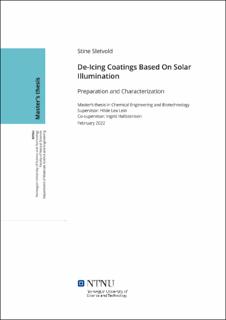| dc.contributor.advisor | Lein, Hilde Lea | |
| dc.contributor.advisor | Hallsteinsen, Ingrid | |
| dc.contributor.author | Sletvold, Stine | |
| dc.date.accessioned | 2022-06-11T17:19:28Z | |
| dc.date.available | 2022-06-11T17:19:28Z | |
| dc.date.issued | 2022 | |
| dc.identifier | no.ntnu:inspera:93321248:15733311 | |
| dc.identifier.uri | https://hdl.handle.net/11250/2998396 | |
| dc.description.abstract | Målet med dette prosjektet har bestått av å lage og karakterisere et overflatebelegg som kan utnytte energien i solstråler til avising av vindmøller og andre installasjoner utsatt for isakkumulering. Belegget består av tre lag med ulike egenskaper som samhandler under belysning for å varme opp egen overflate og fjerne is som har samlet seg på overflaten. Nåværende løsninger for avising er energikrevende og miljøskadelige, dermed er motivasjonen for prosjektet at denne løsningen kan stå som et miljøvennlig og rimelig alternativ.
Hensikten til overflatelaget er å absorbere innfallende stråling og omforme dette til termisk energi, en egenskap vi ville se nærmere på. Overflateegenskaper, hardhet, termiske og optiske egenskaper, samt avisingeffekt hos tre ulike overflatematerialer har blitt undersøkt. To prøver med silisiumkarbid, to prøver med titannitrid, og en prøve med en kombinasjon av de førstnevnte materialene ble laget ved hjelp av keramisk båndstøping.
Beleggenes overflateegenskaper ble karakterisert ved hjelp av sveipeelektronmikroskopi (SEM), uendelig fokusmikroskopi og kontaktprofilometri. Den mekaniske motstandsevnen ble karakterisert ved skrapetesting, og fuktegenskapene ved vannkontaktvinkelmåling. Beleggenes optiske absorberingsevne ble karakterisert ved ultrafiolett-synlig mikroskopi. Termisk ledningsevne ble utledet fra laserflash målinger, og varmekapasitet ble karakterisert ved differensiell sveipekalorimetri (DSC). Et enkelt eksperimentelt oppsett ble så tatt i bruk for å evaluere beleggenes avvisingsegenskaper.
Karakteriseringen av beleggene avdekket noen interessante funn. Overflaten til beleggene ble målt til å være ganske ru, noe som påvirket fuktegenskapene til belegget, og muligens også hvordan is fester seg til overflaten. Beleggene ble målt til å ha lav varmeledningsevne, trolig grunnet mye porositet og høyt innhold av bindemiddel. Den optiske absorpsjonsevnen til materialene ble målt til å være god for beleggenes tenkte formål. Fra avisingskarakteriseringen ser vi at bestråling av beleggene hadde en positiv effekt på smeltingen av is relativt til en ubestrøket aluminiumsoverflate. TiN viste best resultater som overflatelag med tanke på overflateegenskapene, spesielt fuktegenskapene, og tilsynelatende avisingeffekt, noe som understreker korrelasjonen mellom hydrofobitet og isfobitet. | |
| dc.description.abstract | The aim of this project is to prepare and characterize a coating designed to have de-icing properties for use on structures and surfaces exposed to freezing climates. The coating consists of three layers, an absorber layer, a thermal spreader layer and an insulating layer, that interact with each other to utilize incoming radiation from sunlight to mitigate accumulated ice on such structures. Current methods for de-icing are typically energy intensive or can cause environmental damage, making this coating a potentially more effective and less harmful alternative.
The most cruicial properties of the coating lie within the surface (absorber) layer, which purpose is to absorb incoming radiation from a light source and convert it to thermal energy. Mechanical, wetting, thermal, optical and surface properties of three different absorber materials have been investigated, as well as their de-icing properties. Two samples of coatings based on silicon carbide (SiC), two samples based on titanium nitride (TiN) and one sample based on a combination of the two materials were prepared by ceramic tape casting onto aluminium foil.
The surface properties of the prototype coatings were characterized by scanning electron microscopy (SEM), infinite focus microscopy (IFM) and stylus profilometry. The durability of the coatings was characterized by scratch testing, and their wetting behaviour was characterized by water contact angle (WCA) measurements. Their optical absorbance abilities were characterized by ultraviolet-visible (UV-Vis) spectrometry, thermal conductivity values were derived from laser flash measurements, and their heat capacities were characterized by differential scanning calorimetry (DSC). A simple experimental setup was used to evaluate the prototype coatings' de-icing abilities.
The characterization of the prototype coatings showed some interesting results. The surfaces of the prepared coatings were measured to be rough, and this affected their wetting properties, which in turn affects surface ice adhesion. The coatings showed little resistance to scratching, and do not have the desired durability for industrial implementation. The thermal conductivity of the materials was measured to be low, likely due to high porosity and binder content. The coatings were measured to have relatively high optical absorption, which is promising in terms of photothermal conversion. Results from the de-icing characterization showed that the ice mitigation ability was enhanced under illumination, with respect to an uncoated aluminium surface. TiN showed the most promising results as an absorber layer with regard to surface properties, especially surface wetting, and apparent de-icing effect, which emphasizes the correlation between hydrophobicity and icephobicity. | |
| dc.language | eng | |
| dc.publisher | NTNU | |
| dc.title | De-icing coatings based on solar illumination
Preparation and characterization | |
| dc.type | Master thesis | |
